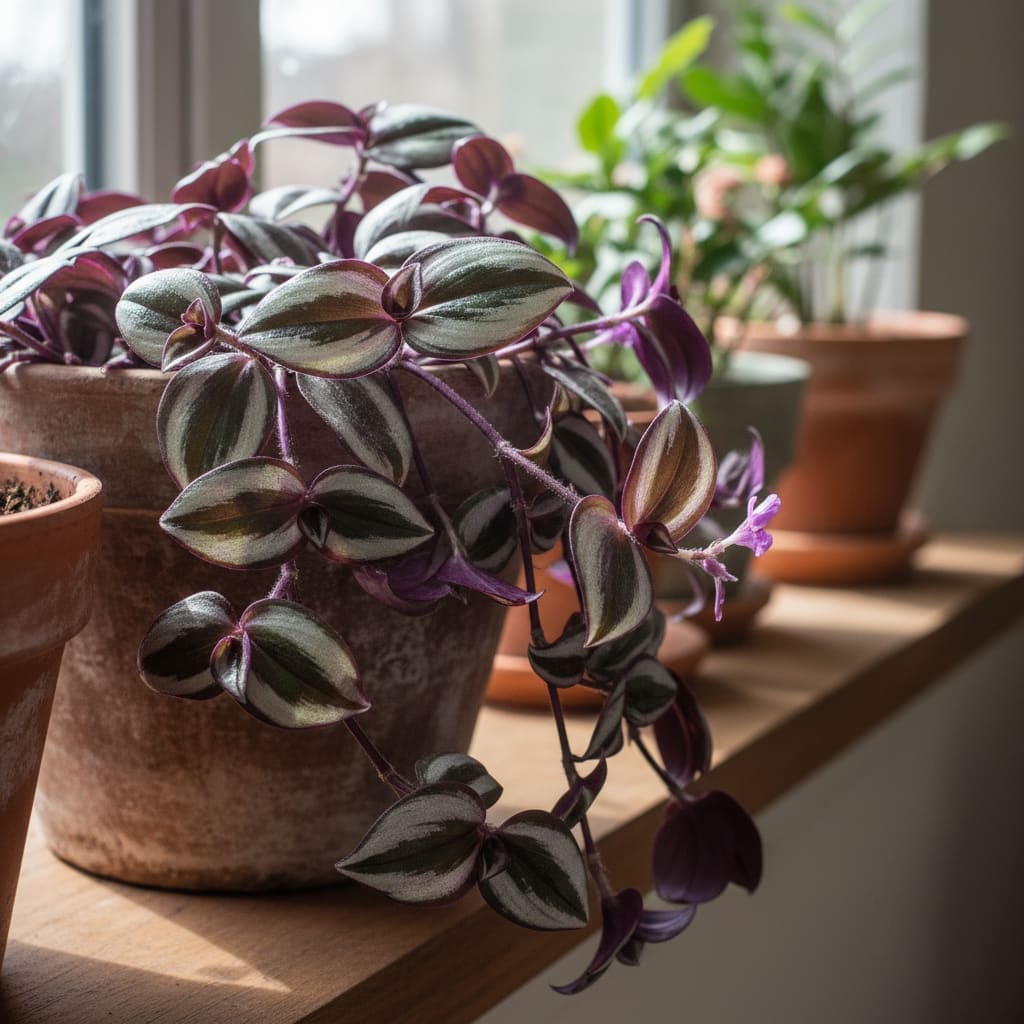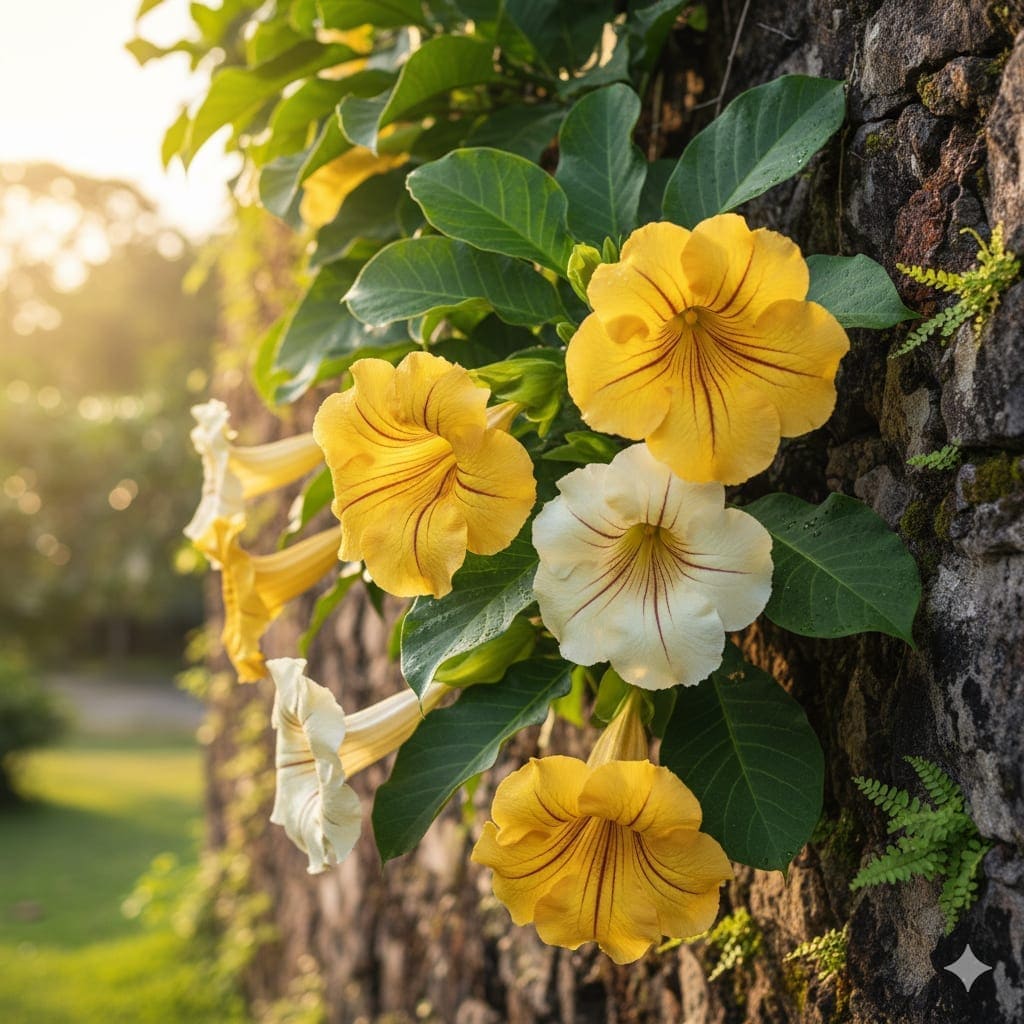Tradescantia zebrina Care & Growing Guide
Overview
Tradescantia zebrina, commonly known as inch plant or wandering dude, is a fast-growing trailing perennial prized for its striking purple, silver, and green striped foliage. Native to Mexico and Central America, it thrives as both an indoor ornamental and an outdoor groundcover in warm climates. Its adaptability and vibrant leaves make it a favorite among beginner and experienced plant enthusiasts alike.
This species is part of the Commelinaceae family and is known for its ease of propagation and ability to quickly fill hanging baskets or climb supports when trained. In the right conditions, Tradescantia zebrina can produce small, three-petaled pink to purple flowers, though it is primarily grown for its foliage.
Identification & Growth Habit
Tradescantia zebrina is a trailing or climbing plant with fleshy stems and ovate leaves. Each leaf typically measures 2–4 inches (5–10 cm) long, with two broad silver stripes running lengthwise over a green background and a rich purple underside. The stems are succulent-like, storing water, and can root easily at nodes when in contact with soil.
In containers, the plant often cascades over the edges, making it ideal for hanging baskets. When provided with a trellis, moss pole, or other support, it can climb, creating a lush vertical display.
Light & Placement
Place Tradescantia zebrina in bright, indirect light to maintain vivid leaf coloration. Too little light can cause the variegation to fade, while too much direct sun may scorch the leaves. A spot near an east- or north-facing window is ideal, or a few feet back from a bright south- or west-facing window with sheer curtains for protection.
Outdoors, it prefers dappled shade or morning sun with afternoon protection. In low-light conditions, expect leggier growth and less intense colors.
Watering & Humidity
Water when the top inch (2.5 cm) of soil feels dry to the touch. During spring and summer, aim to keep the soil evenly moist but never soggy. In fall and winter, reduce watering frequency, allowing the soil to dry slightly between waterings.
Tradescantia zebrina appreciates above-average humidity. Mist the foliage occasionally, group it with other plants, or use a humidifier—especially in dry winter months. Kitchens and bathrooms, with naturally higher humidity, are excellent spots.
Soil & Repotting
Use a well-draining potting mix enriched with organic matter. A standard houseplant mix amended with perlite or coarse sand works well. Good drainage is essential to prevent root rot.
Repot annually or when the plant becomes rootbound, ideally in spring. Refreshing the soil each year helps maintain nutrient availability and prevents compaction.
Fertilizing
Feed every two months during the active growing season (spring through summer) with a balanced, water-soluble fertilizer diluted to half strength. Avoid over-fertilizing, as excessive nutrients can cause leaf variegation to fade. Suspend feeding in fall and winter when growth slows.
Pruning & Training
Regular pruning encourages fuller growth and prevents legginess. Pinch back stem tips to stimulate branching. Remove any yellowing or damaged leaves to maintain plant health.
For a climbing display, train stems onto a trellis, moss pole, or other support. Secure stems gently with plant ties or clips. For a trailing effect, allow stems to cascade naturally from hanging baskets or shelves.
Propagation
Tradescantia zebrina is one of the easiest houseplants to propagate. Follow these steps:
- Select a healthy stem with at least one node (the point where leaves emerge).
- Using clean scissors or pruners, cut just below the node.
- Remove the lower leaves to expose the node.
- Place the cutting in a glass of water or directly into moist potting mix.
- If rooting in water, change the water every few days to keep it fresh.
- Roots typically develop within 1–2 weeks. Once roots are 1–2 inches long, pot the cutting in fresh soil.
Common Problems
Pests
- Spider mites: Look for fine webbing and stippled leaves. Increase humidity and treat with insecticidal soap or horticultural oil.
- Aphids: Small green or black insects on new growth. Rinse with water or apply insecticidal soap.
- Mealybugs: White cottony masses on stems and leaves. Remove with a cotton swab dipped in alcohol.
Diseases
- Root rot: Caused by overwatering or poor drainage. Remove affected roots and repot in fresh, well-draining soil.
- Leaf spot: Brown or black spots may indicate fungal issues. Remove affected leaves and improve air circulation.
Toxicity & Pet Safety
Tradescantia zebrina is considered toxic to pets if ingested, potentially causing irritation to the mouth and digestive tract. Keep out of reach of cats, dogs, and small children.
Styling & Decor Tips
- Use in hanging baskets to showcase trailing stems and colorful foliage.
- Combine with solid green plants for a striking contrast.
- Train on a small trellis for a vertical accent in mixed containers.
- Place near light-colored walls to highlight the purple undersides of leaves.
Varieties & Cultivars
- Tradescantia zebrina ‘Purpusii’: Richer purple tones with less pronounced striping.
- Tradescantia zebrina ‘Quadricolor’: Features green, white, pink, and purple striping.
- Tradescantia zebrina ‘Burgundy’: Deep burgundy foliage with subtle silver markings.
Buying Tips & Maturity
When selecting a Tradescantia zebrina, look for dense, bushy growth with vibrant, well-defined stripes. Avoid plants with yellowing leaves, mushy stems, or signs of pests. Younger plants establish quickly, while mature specimens offer instant fullness for displays.
Seasonal Care
- Spring/Summer: Active growth period—water regularly, fertilize bimonthly, and prune to shape.
- Fall/Winter: Growth slows—reduce watering, stop fertilizing, and maintain adequate light to preserve variegation.
- Protect from cold drafts and temperatures below 50°F (10°C) year-round.
FAQ
- How fast does Tradescantia zebrina grow? In optimal conditions, it grows rapidly, often producing several inches of new growth each month during the growing season.
- Can it live outdoors year-round? Only in frost-free climates (USDA zones 9–12). Elsewhere, grow it indoors or bring it inside before temperatures drop.
- Why are my plant’s leaves losing color? Likely due to insufficient light or over-fertilization. Move to a brighter spot and adjust feeding.
- How often should I repot? Every 12–18 months or when roots outgrow the pot, ideally in spring.
- Is misting necessary? Not essential, but occasional misting can help maintain humidity and reduce spider mite risk.
Sources: Wikipedia, The Spruce






